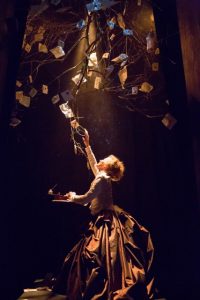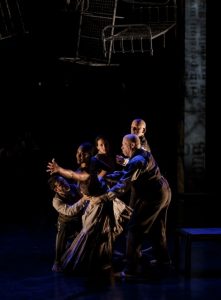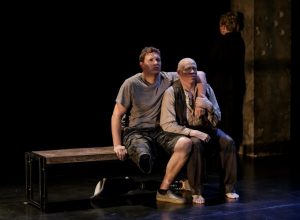Haunting, Cathartic ‘Healing Wars’ Hits Home
When Liz Lerman was rehearsing a new work at Harvard in 2011, there wasn’t theater space, so the choreographer and MacArthur Fellow staged scenes in different rooms. She had the audience walk through them. The journey became the prologue for her haunting and cathartic Healing Wars at La Jolla Playhouse’s Mandel Weiss Forum.

Tamara Hurwitz Pullman in La Jolla Playhouse’s Without Walls production of HEALING WARS, conceived and directed by Liz Lerman, running Sept 29 – Oct 25 in the Mandell Weiss Forum; photo by T. Wood.
The dance-theater work weaves text, projections, and special effects to tell true stories about soldiers, healers, and medicine.
Small groups enter a dark corridor behind the theater to experience battlefield dioramas before taking their seats.
By shrinking the space, we connect with performers and historical objects as stories unfold. We become participants, even hold hands, which makes Healing Wars a smart choice as the anchor production for WoW, Without Walls Festival 2015.
We pass a frantic man tied up in an attic. It was his family’s attempt to keep him out of the Civil War. Nurse Clara Barton, who founded the Red Cross, reads letters from the office of Missing Soldiers. Handwritten letters flutter on branches overhead. Peer over a wall to view a decrepit man assigned to burial detail. Two men talk about a recent hospital stay. The youngest man has a shiny prosthetic leg.
Once seated, we hear mournful guitar and crickets. It’s as if we’re in a Ken Burns Civil War film. I overhear a woman ask her silver-haired partner if he is okay. “Do you want to leave hon?”
Healing Wars hits home. San Diego is a military town and home to thousands of veterans. It’s safe to say no one is untouched by the military or medical research.
By having Jeffry Denman portray a doctor in 1860 and today, we can appreciate how our response to war and its fallout changed. Ether replaced alcohol and opium. Surgeons could ease pain. Regiments were no longer made up of whole towns.
He describes in blunt terms how veterans suffer from depression and loss. Post Traumatic Stress Disorder is not new. It’s always been around but not talked about. His rapid fire presentation of suicide statistics is clinical. “Next slide,” he orders.

The cast of La Jolla Playhouse’s Without Walls production of HEALING WARS, conceived and directed by Liz Lerman, running Sept 29 – Oct 25 in the Mandell Weiss Forum; photo by Jim Carmody.
Lerman rejects easy props like rifles. There’s no mention of God or politics. She employs a spirit woman, a female grim reaper who is exhausted and doesn’t want to cradle anyone. Miko Doi-Smith, a trained dancer and registered nurse, wrestles with soldiers and her job description.
David Israel gets credit for sets and costumes appropriately drab, except for one satiny copper gown that hints of happier, pre-Civil war days. Rusted metal bed frames dangle from the rafters. A sliding white screen reminds us of hospital areas hidden from view.
Nurse Barton wears a canvas jacket with a red cross stitched onto her breast. She becomes a contemporary therapist in a suit and pumps. A woman twirls in a hoop skirt without a fabric cover. Jen Schreiver’s lighting is generally dim, except for explosive special effects. Be warned.
War is hell. Bodies are manipulated on a bench and hung on a wall. Lerman is fascinated with women in war, such as women who dressed as men in order to serve, and those buried alone because of their gender. She studied photographs of soldiers who suffered amputations, and that led to research about PTSD.
The heart of Healing Wars is the healing community. Dance and text intertwine to open difficult conversation. It’s hard to process a young soldier’s horrific flashback to medical training that required her to shoot and torture a pig, only to save it. Meghan Frederick brings youthful honesty to that therapy session. Healing begins when we talk about war and its insidious damage.
Lerman doesn’t sugarcoat. Text in the production comes from real veteran interviews and research. You know a show is deeply depressing when a marching dance with gun-to-mouth and wrist slicing gestures proves uplifting. The entire cast joins in flawless unison. Dancing represents life in the production. Real life veteran Paul Hurley’s true story about losing his leg and phantom pain is unsettling, yet there is profound joy in seeing him dance.

Paul Hurley and Keith A. Thompson in La Jolla Playhouse’s Without Walls production of HEALING WARS, conceived and directed by Liz Lerman, running Sept 29 – Oct 25 in the Mandell Weiss Forum; photo by Jim Carmody
Lerman has said dancers don’t have to be young and skinny, and there is beauty in the untrained body. She founded her multi-generational dance company in 1976 and handed it over to a new generation in 2011.
Smart contributions come from the entire cast taking multiple roles. Keith A. Thompson has mature presence and created the choreography with Lerman, in collaboration with dancers. A lean Ted Johnson impresses in nimble spirals.
Lights fade to black, except for the death spirit’s lantern. Applause will be subdued for this compelling dance theater work. Expect to feel numb. Healing Wars lingers. Our mission is to talk about what we’ve learned from this visceral experience.
Healing Wars continues through Oct. 25. The WoW Festival runs three days, Oct. 9-11. Most performances are in the Playhouse Theatre District. www.wowfest.org.
Local dance troupes at WoW include Jean Isaacs San Diego Dance Theater and UC San Diego Dept. of Theatre and Dance.

Kris Eitland covers dance and theater for Sandiegostory.com and freelances for other publications, including the Union Tribune and Dance Teacher Magazine. She grew up performing many dance styles and continued intensive modern dance and choreography at the Univ. of Minnesota, Duluth, and San Diego State Univ. She also holds a journalism degree from SDSU. Her career includes stints in commercial and public radio news production.
Eitland has won numerous Excellence in Journalism awards for criticism and reporting from the San Diego Press Club. She has served on the Press Club board since 2011 and is a past president. She is a co-founder of Sandiegostory.com. She has a passion for the arts, throwing parties with dancing and singing, and cruising the Pacific in her family’s vintage trawler. She trains dogs, skis, and loves seasonal trips to her home state of Minnesota.
